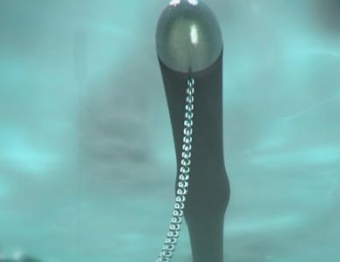Anaconda, a giant rubber "snake" that floats offshore and converts wave energy to electricity, is a step closer to commercialisation. An 8-metre long, 1/25th scale version is currently undergoing tests in a large wave tank in Gosport, UK, and a full-size
Harnessing the power of waves is an attractive proposition because they are much more energy dense than wind. But wave power remains the poor relation of the renewable energy sector due to the difficulties of cheaply operating machinery in the harsh marine environment. The world’s first commercial wave farm only began operating last year, off the northern coast of Portugal.
A variety of other designs are in testing around the world, but none are as unusual as the Anaconda. The rubber snake is filled with freshwater – to help deter sea creatures from setting up a home inside – and sealed at both ends to create a semi-rigid balloon that floats at the sea’s surface.
Wave pulse
The tube is anchored at one end and as waves wash along its length they exert pressure on the snake that is transmitted by the water inside. This forces Anaconda’s walls to expand outwards into the wave troughs where they are under less pressure, forming “bulge waves” that travel along the Anaconda’s length.
These waves are similar to those that pass through the human circulatory system and can be felt as the pulse in the wrist and neck, says Rod Rainey of Atkins Global, co-inventor of the Anaconda. When each bulge wave reaches the end of the snake it keeps a turbine spinning to generate electricity.
The snake is made from a rubber-based material similar to that used to make dracones – flexible containers that are filled with diesel or water and towed behind ships for quick and cheap transportation.
Other than the turbine, Anaconda has no moving parts and unlike other wave power devices it needs only one tether to the ocean floor. That lowers construction costs and reduces the need for maintenance – an expensive undertaking in offshore settings where corrosion and accessibility are problems, explains Rainey.
Full-size snake
Des Crampton, CEO of Checkmate Seaenergy, the firm commercialising the flexible wave harvester, says a full-size Anaconda 200 metres long could generate enough energy to power 1000 average homes. “Anaconda captures more energy than all existing wave energy devices,” he says.
Rainey and retired physicist Francis Farley began work on the concept in 2007, and tested mini Anacondas last year. The first full-size Anacondas could become operational in 2014.
That would leave Anaconda several years behind competing technologies, such as the Pelamis system currently operational off the Portuguese coast. But paradoxically, Rainey thinks success for Pelamis will be crucial for the future of Anaconda. “It will deeply upset the investment community if Pelamis fails,” he says.







